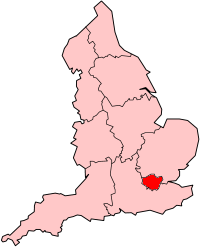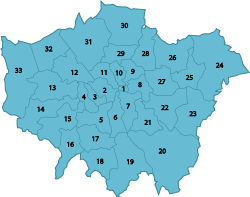London borough
| London borough | |
|---|---|
 Greater London shown within England |
|
| Category | Districts |
| Location | Greater London |
| Created by | London Government Act 1963 |
| Created | 1 April 1965 |
| Number | 32 (as at 2008) |
| Possible types | Inner London (12) |
| Outer London (20) | |
| Possible status | City (1) |
| Royal borough (2) | |
| Populations | 150,000–300,000 |
| Areas | 15–150 km² |
| Government | London Borough Council (31) |
| City Council (1) | |
The administrative area of Greater London contains thirty-two London boroughs. Inner London comprises twelve of these boroughs plus the City of London. Outer London comprises the twenty remaining boroughs of Greater London.
Contents |
Functions
The London boroughs are administered by London Borough Councils which are elected every four years. The boroughs are the principal local authorities in London and are responsible for running most local services in their areas, such as schools, social services, waste collection and roads. Some London-wide services are run by the Greater London Authority, and some services and lobbying of government are pooled within London Councils. Some London borough councils also group together for such services as waste collection and disposal, e.g. the West London Waste Authority. The London boroughs are local government districts and have similar functions to metropolitan boroughs. Each London borough is a Local Education Authority. Until 1990 the Inner London boroughs were served by a shared LEA, the Inner London Education Authority.
Nomenclature
There are three boroughs which do not use the term "London Borough of" in their names. They are Westminster, which is termed the City of Westminster as it has city status; and Kingston upon Thames and Kensington and Chelsea, which are termed "Royal Borough of", due to their Royal borough status. The Queen has also bestowed the status of Royal Borough upon Greenwich, to take effect in the year of the Diamond Jubilee in 2012. Additionally, the council for Westminster is termed Westminster City Council.
List of boroughs
Map
| London |
This article is part of the series: |
|
|
|
Governance
Boroughs
Elections
Functional bodies
Transport
Policing
In the UK
In the EU
Other
|
|
Other countries · Atlas |

 |
|
History
The present London boroughs were created by the London Government Act 1963. They came into existence on 1 April 1965 with the creation of Greater London. The first London Borough elections had been held in 1964 with the newly elected London Borough Councils acting as "shadow" authorities before coming into power the following year.
They had wider authority than the inner London metropolitan boroughs and neighbouring urban districts and municipal boroughs which they mostly replaced, but less power than the three county boroughs of Croydon, West Ham and East Ham, which ceased to exist at the same time.
Between 1965 and 1986 the London boroughs were part of a two-tier system of government, and shared power with the Greater London Council (GLC). However on 1 April 1986, the GLC was abolished, the London boroughs inherited most of its powers and became in effect unitary authorities (combining both county and borough functions). Since the creation in 2000 of a new Greater London Authority, covering the former GLC area but with more limited powers, the boroughs now have powers similar to those of English unitary authorities.
The City of London is administered by its own distinct body, the City of London Corporation, which predates the London boroughs.
The word borough has cognates in virtually every Germanic language, as well as other Indo-European languages. For a fuller explanation, see under borough.
Former authorities
The boroughs were created as follows. There have been some changes to boundaries and some boroughs have been renamed since 1965.
| Inner London borough | Former areas | ||
|---|---|---|---|
| Camden | Hampstead (11a) | St Pancras (11b) | Holborn (11c) |
| Greenwich | Greenwich (22a) | Woolwich (part) (22b) | |
| Hackney | Hackney (9a) | Shoreditch (9b) | Stoke Newington (9c) |
| Hammersmith | Hammersmith (4a) | Fulham (4b) | |
| Islington | Islington (10a) | Finsbury (10b) | |
| Kensington and Chelsea | Kensington (3a) | Chelsea (3b) | |
| Lambeth | Lambeth (6a) | Wandsworth (part) (6b) | |
| Lewisham | Lewisham (21a) | Deptford (21b) | |
| Southwark | Bermondsey (7b) | Camberwell (7c) | Southwark (7a) |
| Tower Hamlets | Bethnal Green (8a) | Poplar (8c) | Stepney (8b) |
| Wandsworth | Battersea (5b) | Wandsworth (part) (5a) | |
| Westminster | Paddington (2c) | St Marylebone (2b) | Westminster (2a) |
| Outer London borough | Former areas | ||||
|---|---|---|---|---|---|
| Barking | Barking (part) (25a) | Dagenham (part) (25b) | |||
| Barnet | Barnet (31a) | East Barnet (31b) | Finchley (31d) | Hendon (31c) | Friern Barnet (31e) |
| Bexley | Bexley (23b) | Erith (23a) | Crayford (23c) | Chislehurst and Sidcup (part) (23d) | |
| Brent | Wembley (12a) | Willesden (12b) | |||
| Bromley | Bromley (20c) | Beckenham (20b) | Orpington (20e) | Penge (20a) | Chislehurst and Sidcup (part) (20d) |
| Croydon | Croydon (19a) | Coulsdon and Purley (19b) | |||
| Ealing | Acton (13b) | Ealing (13a) | Southall (13c) | ||
| Enfield | Edmonton (30c) | Enfield (30a) | Southgate (30b) | ||
| Haringey | Hornsey (29b) | Tottenham (29c) | Wood Green (29a) | ||
| Harrow | Harrow (32) | ||||
| Havering | Romford (24a) | Hornchurch (24b) | |||
| Hillingdon | Hayes and Harlington (33c) | Ruislip Northwood (33b) | Uxbridge (33a) | Yiewsley and West Drayton (33d) | |
| Hounslow | Brentford and Chiswick (14c) | Feltham (14a) | Heston and Isleworth (14b) | ||
| Kingston upon Thames | Kingston upon Thames (16a) | Malden and Coombe (16b) | Surbiton (16c) | ||
| Merton | Mitcham (17c) | Merton and Morden (17b) | Wimbledon (17a) | ||
| Newham | East Ham (27a) | West Ham (27b) | Barking (part) (27c) | Woolwich (part) (27d) | |
| Redbridge | Ilford (26a) | Wanstead and Woodford (26b) | Dagenham (part) (26c) | Chigwell (part) (26d) | |
| Richmond upon Thames | Barnes (15a) | Richmond (15b) | Twickenham (15c) | ||
| Sutton | Beddington (18c) | Carshalton (18b) | Sutton and Cheam (18a) | ||
| Waltham Forest | Chingford (28a) | Leyton (28c) | Walthamstow (28b) | ||
See also
- The Five Boroughs (New York City)
- Borough
- ISO 3166-2:GB, subdivision codes for the United Kingdom
- Political make-up of London borough councils
|
||||||||||||||
|
||||||||||||||
|
|||||||||||